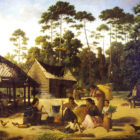An Early Account OF The Choctaw Indians: Part 2

They have by way of furniture only an earthen pot in which to cook their food, some earthen pans for the same purpose, and some fanners or sieves and hampers to prepare their corn, which is their usual nourishment. They pound it in a wooden crusher (pile) or mortar, which they make out of the trunk of a tree, hollowed by means of burning embers. The pestle belonging to it is sometimes ten feet long and as small around as the arm. The upper end is an un-shaped mass which serves to weigh it down and to give force to this pestle in falling back, in order to crush the corn more easily.
After it is thus crushed they sift it in order to separate the finer part. They boil the coarser in a great skin which holds about three or four sceau of water, and mix it sometimes with pumpkins, or beans, or bean leaves. When this stew is almost cooked they throw into it the finest of the corn which they had reserved to thicken the water, and by way of seasoning they have a pot hung in the air in which are ashes of corn silk, beanpods, or finally oak ashes, on which having thrown water they take the lye which has fallen into a vessel provided underneath, and with it season their stew which is called sagamite. This serves as their principal food, and as well that of the French who are in the colony who have not the means of living otherwise.
They sometimes make bread without lye, but rarely, because that consumes too much corn, and it is difficult to make, since they reduce it to flour only with the strength of their arms; after which it is kneaded or they boil it in water, or wrap it in leaves and cook it in the ashes, or finally having flattened the paste to the thickness of two crowns (ecus), and the diameter of the two hands, they cook it on a piece of a pot on the embers. They also eat it with acorns. After having reduced the acorns to flour they put them in a canesieve placed near the bank of a stream, and from time to time throw water upon them. By means of this lye they cause it to lose its bitterness, after which they put the paste around a piece of wood which they cook in the fire.
When they have meat they boil it in water, however dirty it is, without washing it, saying that that would make it lose its flavor. When it is cooked they sometimes put some of the acorn flour into the broth. They also cook unpounded corn with their meat, and when it is dry they pound it and reduce it to lint (charpie). They mix it in boiling with this corn. That has no taste and one must be a savage to eat it.
While the corn is green is the time when they hold the most feasts and they prepare it in different ways. First they roast it in the fire and eat it so; many French eat it thus. When it is very tender they pound it and make porridge of it, but the most esteemed among them is the cold meal. It is corn, considerably mature, which they boil, then roast to dry it, and then they pound it; and this flour has the same effect in cold water as wheat flour put into hot water over the fire and has a taste sufficiently agreeable; the French eat it with milk. They also have a species of corn which is smaller than the other and which comes to maturity in three months. That they dry and then without pounding it boil it with meat. This little corn, boiled with a turkey or some pieces of fat meat, is a favorite dish with them.
